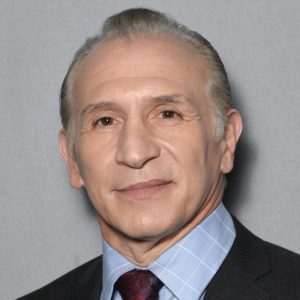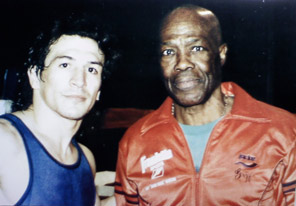A Conversation With Ray Mancini: “Boom Boom” Pays Homage To Murphy Griffith
[AdSense-A]
 Exclusive Interview by Anthony “Zute” George
Exclusive Interview by Anthony “Zute” George
For boxing fans, when they hear, Youngstown, Ohio, they cannot help but think of Ray Mancini. Indeed, there was a proud boxing tradition in Youngstown long before “Boom Boom” laced ‘em up; such as Ray’s dad Lenny Mancini, Jimmy Jones, and Tony Janiro. But Ray picked up the boxing torch at a time where it was not lit for a long time, “There was a long period of time where nobody was turning pro (from Youngstown, Ohio). If they did, they became road warriors. Nobody knew them. I was the first one that turned pro that stood in Youngstown. I was proud that I kind of led the way again.” Ray fought as a professional in Ohio on a handful of occasions and was always recognized as a Youngstown fighter.
With that said, Youngstown has other schemas and norms that the Hall of Famer understood and appreciated, but wanted very little part of, “Youngstown was the second biggest steel-producing city in the world. We were a true melting pot. Immigrants from Eastern and Western Europe came to work in the steel mills. Middle-class neighborhoods…everyone had a job. You can own your house, send your kid to private school. It was great. My whole neighborhood was basically mill rats. You didn’t talk about going to college…you would graduate high school, get a job, meet a nice girl, raise a family. A quality life. But I wanted something different. I couldn’t do that. Since I was a little boy, I dreamed of being a world champion,” Ray explained. Mancini fulfilled that dream and did so exponentially. Part of the reason why Ray became so successful in boxing was that he was cut from a different cloth; anyone who knows Ray’s life story knows precisely how, “you had to work hard for it because Youngstown was not encouraging anything out of the steel mills at that time.”
Another part of why Ray was able to compete on boxing’s highest level was because of Murphy Griffith, his often-forgotten trainer, “Murphy Griffith first saw me in 1979 National Golden Gloves in Indianapolis. He was sent there by my eventual manager David Wolf, to find the best  professional prospect. He picked three of us. I was the first one. The other two were Gene Hatcher and Lee Roy Murphy. Both wound up winning world titles. He had a great eye for talent. Griff was the uncle of Emile Griffith.
professional prospect. He picked three of us. I was the first one. The other two were Gene Hatcher and Lee Roy Murphy. Both wound up winning world titles. He had a great eye for talent. Griff was the uncle of Emile Griffith.
He was a thirty-year Navy man. He trained Navy fighters. Griff was from the old school. He could show you everything he wanted you to do. He wasn’t a towel waver. He would show me how he wanted me to throw (punches). Griff would get up and do road work in the morning. When he took his shirt off, he embarrassed me. He looked the part. He would not scream at you; he would teach you. In that one-minute time (in between rounds), he would give me exactly what I needed for the next round. He was the perfect trainer in the corner.”
Of course, Ray himself has never forgotten Murphy, “He was the best. I loved that man as much as I have loved anybody.” Murphy really earned his paycheck with his approach to sparring, it is a crucial aspect of boxing, and Ray has put sparring in its proper perspective, “I sparred with Stevie Cruz for the Ramirez fight. Griff was smart, we had three southpaws and one orthodox fighter. Stevie Cruz was lighter, and we used him for speed. I also sparred with Frankie Randall, man, that kid could fight. I sparred with Juan Escobar, who fought Salvador Sanchez to a draw. I had one guy from Harlem, Eddie Campbell, he gave everyone fits, Saoul Mamby, Duran, Billy Costello. He was a great sparring partner for me. But he could not take it to the next level. He could not win a fight because he was out of his comfort zone. There was a lot of those type of guys. I learned from all these guys. One thing I learned from Griff about sparring, you are not winning any fight in the gym. We are not there to win fights; we are there to learn. So, if you want to make a war of it, this ain’t the place. We ain’t getting paid for that. But sometimes these guys wanted to make a war of it, and you had to once in a while.”
Climbing up the rankings, that sparring came in handy, as Ray was pitted against the rugged southpaw Jose Luis Ramirez. Mancini put on a boxing clinic in that fight and remembers how valuable Murphy Griffith’s words were, “I was boxing him, putting on a clinic, and Griff just said, ‘Man, you are looking beautiful. Keep doing what you are doing.’ I was boxing, that was not my normal style, and he was letting me know I was doing it right,” Ray explained. Ray also gives credit to Murphy for choosing to box against the complicated southpaw, “We knew that he was a guy who was aggressive.
As I was. He was a southpaw. He hit pretty good, and he took a great punch. So, Griff said, ‘You could stand there and make a war of it. But then anything can happen. Or, you could beat him the easiest way.’ That was another thing he taught me, how to beat fighters the easiest way.
You always try and beat a guy the easiest way. Some guys, you are just not going to be able to knockout. Some guys are going to have a heck of a chin. And I thought I could outbox Ramirez.” Indeed, no more exact words have ever been spoken.
Ray’s stellar performance against Ramirez was on CBS for all to see. The victory secured Ray a title shot against Alexis Arguello, the WBC lightweight champion. Arguello already had a reputation of being an all-time great, and He and Ray fought in an all-time classic. Ray did not fulfill his dream of being a world champion against Arguello, but he learned a very precious lesson, as well as making a new friend, “Alexis Arguello was without a doubt the strongest fighter that I’ve faced. Physically, mentally, emotionally. I learned from Alexis. No matter what I hit him with, he never lost his composure. Alexis sets traps early in the fight, then he goes back later in the fight and gets them traps caught. I learned quite a bit. After that fight with Alexis, I knew I would be a world champion.”
Ray was able to test his theory out, as he had a chance to become a world champion against WBA champion Arturo Frias. The fight was one of the greatest one-round battles in the history of boxing. Ray recalls Murphy Griffiths words before the fight, “He gave me the motivational talk before we went out to fight him. He told me how hard I worked, how I deserved this, then he said, ‘Now go out there and knock this boy out.’ Griff was just one of those guys that you wanted to win for. He was the type of guy that you wanted to put your heart and soul on the line for him.”
The title-winning effort against Frias cannot be measured in the two-minutes and fifty-four seconds it took, as the action that unfolded in that amount of time was exhilarating. “It was a great fight for me. He caught me early on and hurt me. But one thing I learned when you are hurt, you either keep firing back, or you cover up. I chose to fire back, and I wound up catching him. I was just trying to make it to the next round. But I hurt him, jumped on him and we finished the fight.”
Ray retired with a hall of fame resume and was one of the most famous boxers of all-time. Ray’s fame was just a part of what he wanted for himself, and he says he has always been comfortable with his celebrity status, “There is no downside of being a champion. Nobody is prepared for the exposure worldwide. You can’t comprehend how big you can become. That was a different part for me. But I had fun with it. I never let it overwhelm me. It is borrowed time anyhow, so you got to enjoy it. It’s not going to last forever, enjoy it as long as you can. Don’t take it for granted. I don’t believe I did.”
Ray also knew the value of fighting, knowing that all aspects of fighting were legitimate, and wanted to be competent if he ever had an encounter that went to the ground. Ray took up training in Brazilian Jiu-Jitsu, earning a purple belt under Renato Magno. “I wanted a different type of training. In the street, nine times out of ten you are going to the dirt (in a fight), if that happens, I want to know how to defend myself. I wanted to know how to fight on my back. I did not want any eighteen-year old kid choking me out on the street. What I love more than anything about Brazilian Jiu-Jitsu is the philosophy, you don’t have to win every fight, you just don’t lose it. With BJJ, you are on your back eighty percent of the time. So, you want to neutralize your opponent.”
In 2015, Ray’s blood, sweat, and tears earned him enshrinement into the International Boxing Hall of Fame in Canastota, New York. “I got a call telling me I was going to be on the ballot. Just to be on the ballot, that alone, I felt like I just won the world title. Then when they called me back to let me know that I made it, it was surreal. I never fought for that reason. I told them, I never thought that my career warranted being in the hall of fame because when you think of the hall of fame, you think longevity. I fought five and a half years. I thought I did not fight long enough to warrant hall of fame status. But the guy who called me told me it was not the quantity of my fights; it was the quality of my fights. I said, ‘Alright, I’ll take it.’ I was very flattered.”
Hall of Fame Weekend in Canastota can be incredibly fast-paced. Fighters are dragged around, and their signature on various memorabilia pieces is in high demand. Much of the demand is from genuine fans who want to build a collection that they would never sell, such as yours truly. However, there are also a seedy bunch of dealers who are just out to make a buck off the fighters’ names. A practice that can catch the ire of many hall of famers. Including Ray, “One guy gave me a bunch of stuff to sign, and I asked him what were the chances he was keeping any, he said, ‘slim to none,’ I said, ‘At least you’re honest, now get out of here.’ You know these guys are going to sell, the guys from the hall are going to sell, at least make sure we get some money out of it. They commercialized it a little too much, took a little bit of the fun away for me. But it still was one of the greatest weekends of my life.”
Ray admits that the constant pursuit of making money off his autograph took some of the shine away from the weekend, so much so that he has not returned since 2015. “I get asked back every year and have not been back for that reason. It was too much. You come out of your room, and they are in the lobby. You got to have some security for the fighters. And if you say no, you are a bad guy. So, I do not want to put myself in that position.”
Today, Ray works as a color analyst for Fox Sports. Ray works on fights under the PBC, where the polarizing Al Haymon is at the helm. Ray says he does not work directly for Al Haymon, but for the Fox Network, but understands Al’s role in the boxing that he commentates on. For Ray, Al is not the evil man behind the curtain that so many in the world of social media wish to portray him as, “Al Haymon is who asked me. He told me, ‘you are the first one we are hiring.’ So, how can I hate a guy who appreciates what I bring to the table? And I love what he is doing for fighters. He is great for fighters. Bob Arum was the best promoter in the world for a long time. And I still think he is the best in many ways. But pound for pound, fight for fight, we have the best product on television. We are bringing it back on free TV. It is great for the fight fans. It is easy to talk about something you know about. I get to travel to great places. I get to know the fighters. I am a lover of fighters. I get to meet them; I get to know them on a personal basis. It is a lot of fun. It is a great gig; I am going to ride it as long as I could.”
Being around young fighters all the time, Ray often asks young fighters why they want to turn professional, Ray explains that he often hears the wrong answer, “I hear, ‘I want to make money.’ I say, ‘No, kidding, get a job.’ Only ten percent of professional fighters make a living without having a second job. I hear, ‘To meet girls.’ I say, ‘No shit, get a personality.’ I also hear, ‘To be famous.’ I tell them don’t do this for these reasons. You are doing it for the wrong reasons. If I do not hear immediately that they want to do it to be a world champion, then I tell them they have to seriously think about what they are doing. Because that is the only reason people should want to fight, to be a world champion.”
One world champion that Ray is really fond of today is Leo Santa Cruz, “This kid gets it. He really understands that you have an obligation to the fans to give them the best fight possible. He never cheats the fans. And he is as humble as they come. The type of kid you just love to root for.” Ray is also very fond of WBC Heavyweight Champion, Deontay Wilder, “He is the most exciting heavyweight since Mike Tyson. He tries to knock you out with every punch. He is fun to watch.”
On their path to trying to become a world champion, Ray would like to see some rule changes that he thinks would make boxing a better, safer product for inspiring champions, “They need to go back to weighing in the morning of. All you need is four to six hours to replenish, Now, they weigh in the day before, I say, ‘why don’t you weigh in the week before? Because it doesn’t mean anything.’ That is the number one change I would want. Number two is to go back to fifteen rounds. It was a TV decision to go to twelve rounds, not a medical decision. TV is the true promoter. TV is who calls the shots. Doctors have come out and rebuffed the medical reasons. It is very upsetting because they think the fans are stupid. They should just come out and say what it is. They changed the day of the weigh-in and the number of rounds for TV purposes.”
When Ray is not working as a boxing analyst, he is back home at Youngstown, Ohio, working on the Ray Boom Boom Mancini Foundation, “When I moved back to Youngstown almost five years ago, I started my foundation. That is one thing I am most proud of. We are doing work in my hometown. We are trying to focus on the youth, elderly, and the military.” Ray is just another example of a boxer looking to give back. We thank him for risking his life for our entertainment, and all the good he is trying to do now.
Will the day ever come when we get to see Ray’s favorite fighter today, Leo Santa Cruz, weigh in the day of a fight, and do battle for fifteen rounds?
Stay tuned…
[si-contact-form form=’2′]

